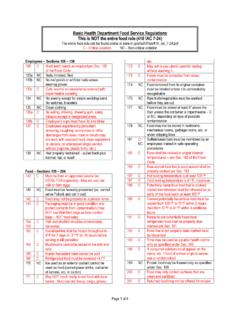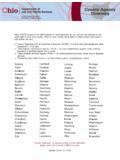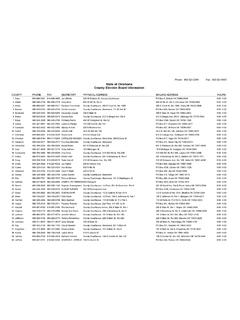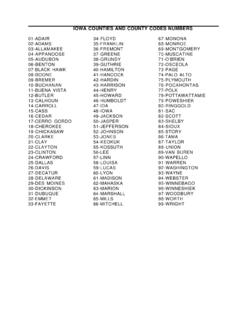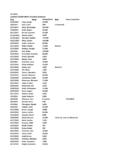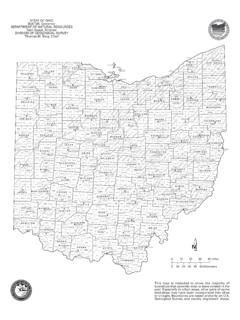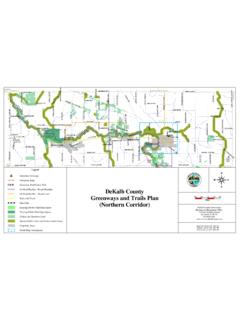Transcription of Chicago and Cook County Paid Sick Leave …
1 Inside xThe Basics xCarryover xAvoiding Tracking of Accrued Time or Carrying Over xLimits on Use xOther Differences between cook County and Chicago (Draft) RulesChicago and cook County paid sick Leave OrdinancesA Differential Diagnosis of Implementing RulesFor more information, please contact FordHarrison LLPK imberly A. Ross, Partner - Chicago , Illinois312-960-6111 or R. Thorstenson, Partner - Chicago , Illinois312-960-6116 or Chicago and cook County paid sick Leave Ordinances: A Differential Diagnosis of Implementing RulesAs most employers in the Chicagoland area are hopefully already aware, both Chicago and cook County have enacted paid sick Leave ordinances that go into effect July 1, 2017 (The Chicago Minimum Wage and paid sick Leave ordinance and cook County Earned sick Leave ordinance ).
2 Although the two ordinances are remarkably similar as written, the two jurisdictions have set forth rules that interpret the ordinances that are remarkably different. cook County s Interpretative and Procedural Rules went into effect on May 25, 2017. Chicago s Minimum Wage and paid sick Leave Rules are still in draft form and were open to public comment until June 16, 2017 (and although the date for final rules is unknown, attorneys with the City have indicated that the final rules will be published before July 1, 2017).
3 Based on comments made by the attorneys charged with drafting the City s rules, we are expecting some changes to be made to the final rules, some possibly significant. We will amend this article as soon as the final rules have been published. This, of course, is of no comfort to Chicago employers attempting to comply with the new ordinance by updating or drafting new paid sick Leave policies. Moreover, given how many employers operate both in cook County and in Chicago , having two completely different sets of rules to interpret virtually the same ordinances would be extraordinarily cumbersome and burdensome.
4 It should also be noted that as of June 22, 2017, 66 municipalities in cook County have opted out of the earned sick Leave ordinance , noted here, and several more are considering opting out as of the time this article was article will provide some of the main points in the two ordinances that employers need to know. We have also prepared a chart that compares the two jurisdictions rules interpreting the two ordinances (again, Chicago s are not final and therefore, we will be updating it after the final rules go into effect), focusing on the most important differences for employers to be aware of now.
5 We have previously prepared more detailed articles on both ordinances, which can be found here for Chicago and here for cook County . This article is intended to provide an overview of each ordinance and its respective rules and is not intended to cover every aspect of the ordinances. Employers located or doing business in either cook County or Chicago are urged to contact their employment counsel to determine whether their current policies comply with the ordinances requirements, or whether they will need to draft entirely new Rate and CapBoth ordinances require employers to provide certain employees with one hour of paid sick Leave for every 40 hours worked.
6 ( cook County s ordinance refers to the Leave as earned sick Leave but for the sake of consistency, we will simply refer to both as paid sick Leave or PSL. Note that both sets of rules further identify and attempt to define types of PSL, which is noted in the comparison chart.) Both ordinances set an earning cap of 40 hours in a year unless the employer chooses to provide Where Work PerformedChicago s ordinance applies to employers who maintain a business facility in Chicago and/or who are required to obtain a business license to operate in the City.
7 cook County s ordinance applies to employers that gainfully employ at least one Covered Employee with their principal place of business within cook County . A Covered Employee is one who performs at least two hours of work in a two-week period for an employer while physically present within cook County . For employees to be eligible under both ordinances, they must work at least 80 hours for an employer in any 120-day period of time; thus most part-time, non-seasonal workers will qualify. Only the work performed in these jurisdictions counts toward PSL BasicsFordHarrison LLP | | Revised June 20171 Accrual and Accrual PeriodWe will refer to the accrual period as the year throughout this article; however, employers can designate the year as either an anniversary year, calendar year, fiscal year, or any other one-year period.
8 If the employer chooses, however, to calculate based on anything other than an anniversary year, it must make sure to initially provide enough hours so that the employee is not worse off than if the employer calculated only by an employee s anniversary in terms of accrual, carryover, and the time in which the employee may use the earned Leave . Chicago s draft rules provide that if an employer s benefit year begins after an employee s start date, the employer shall allow the employee to carry over all of the accrued paid sick Leave , up to 20 hours, to the benefit year.
9 cook County s rules provide two possible ways to move an employee to a different accrual period than based on an anniversary. First, the employer can frontload a greater amount of earned sick Leave than that to which the covered employee is otherwise entitled. Second, at the end of the first accrual period, the employer can allow the employee to carry over all of his unused earned sick Leave rather than just half. Thus, unlike Chicago , which would limit the carry over to 20 hours, cook County s would require carry over of up to 40 hours.
10 Ultimately, Employers will need to do so at their own risk, and err on the side of caution, particularly as it relates to carryover and the time in which an employee has to use up the earned PSL. Under both ordinances, employees begin to accrue PSL on their first day of employment, and both allow for an employer to require a waiting period of 180 days before taking the Leave . Neither ordinance requires employers to pay out unused PSL upon termination. Usage of sick LeaveBoth ordinances allow for the use of paid sick Leave for the same reasons: 1) for an employee s illness or injury (including medical care, treatment and diagnosis) and preventative medical care; 2) if an employee needs to care for an ill or injured family member or if a family member is receiving preventative care; 3) if an employee or family member is victim of domestic violence or a sex offense.



